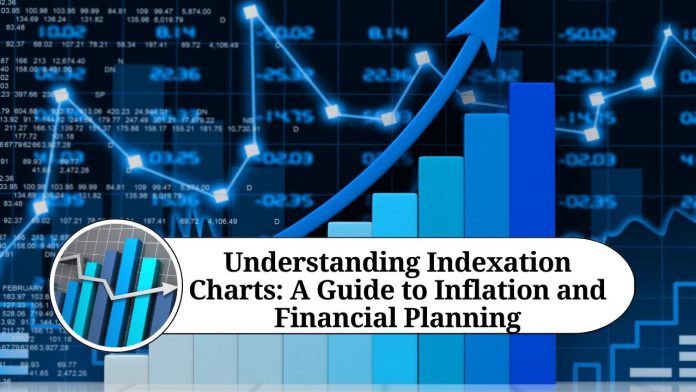An indexation chart, also known as an inflation index chart or cost-of-living index chart, is a tool that helps individuals or organizations understand how inflation affects the purchasing power of money over time. In this blog, we will explore the basics of indexation charts and how they can be used to make informed financial decisions.
What is an Indexation Chart?
An indexation chart is a graphical representation of how the cost of a specific set of goods and services changes over time due to inflation. The chart typically shows the percentage change in the cost of living from one year to the next. The chart may focus on the inflation rate of a specific country or region, or it may provide a global overview of inflation.
An indexation chart can be used to compare inflation rates over time and make predictions about future inflation rates. It is important to note that an indexation chart does not provide an exact value for inflation but rather a general overview of how inflation affects the cost of living.
How is an Indexation Chart Created?
An indexation chart is created by selecting a set of goods and services that represent the average cost of living for a particular country or region. This set of goods and services is called a basket of goods, and it includes items such as food, housing, transportation, and medical care.
Once the basket of goods has been established, the cost of each item is measured over time. The cost of each item is then weighted according to its importance in the basket of goods. For example, the cost of housing may be given a higher weight than the cost of clothing because housing is a more significant expense.
The weighted costs are then combined to create an inflation index. The inflation index represents the average cost of the basket of goods over time. The index can be plotted on a graph to create an indexation chart.
How is an Indexation Chart Used?
An indexation chart is a valuable tool for individuals and organizations who want to understand how inflation affects their purchasing power over time. For example, an investor who wants to invest in a particular asset may use an indexation chart to determine whether the asset is likely to appreciate in value over time.
Similarly, an individual who wants to plan for retirement may use an indexation chart to determine how much money they will need to save in order to maintain their standard of living in retirement.
An indexation chart can also be used by policymakers to make decisions about monetary policy. For example, a central bank may use an indexation chart to determine whether it needs to raise or lower interest rates in order to control inflation.
Significance of Indexation Charts
Indexation charts are significant because they help us understand the impact of inflation on the purchasing power of money. As prices rise due to inflation, the same amount of money can buy fewer goods and services. This is why indexation charts are useful in measuring the impact of inflation on the cost of living.
Indexation charts can also help us understand the relative performance of different economies. If the inflation rate in one country is higher than that of another country, the cost of living in the first country will rise faster than in the second country. This can make goods and services from the second country more attractive to consumers, potentially affecting trade and investment decisions.
Using Indexation Charts for Financial Planning
Indexation charts can be used in financial planning to help individuals and organizations make informed decisions about spending, saving, and investing. For example, if an individual wants to retire in 20 years and maintain their current standard of living, they can use an indexation chart to estimate the amount of money they will need to save in order to offset the impact of inflation.
Similarly, investors can use indexation charts to evaluate the performance of different investment options. An investment that outperforms inflation is said to have a positive real return, meaning that the investor’s purchasing power has increased. By contrast, an investment that underperforms inflation is said to have a negative real return, meaning that the investor’s purchasing power has decreased.
Limitations of Indexation Charts
Despite their usefulness, indexation charts have some limitations. For example, they may not reflect the unique spending patterns of individual consumers. The basket of goods used to calculate the inflation index is based on a general representation of the average cost of living, but individual consumers may spend more or less on certain categories of goods and services.
Another limitation of indexation charts is that they do not account for changes in the quality of goods and services over time. For example, the cost of a particular product may increase over time, but the product may also be of higher quality or have additional features. This can make it difficult to accurately compare prices over time.
Conclusion
In conclusion, indexation charts are a valuable tool for understanding how inflation affects the cost of living over time. They can help individuals and organizations make informed financial decisions and evaluate the performance of different investment options. However, it is important to keep in mind their limitations and use them as a general guide rather than a precise measure of inflation.
Read more useful content:
- How to Save Tax on Salary
- Guide to Understanding Direct Taxes in India
- Filing Income Tax Returns
- GST E-invoice
Frequently Asked Questions (FAQs)
Q1. What is an indexation chart?
An indexation chart is a graphical representation of how the cost of a specific set of goods and services changes over time due to inflation. It shows the percentage change in the cost of living from one year to the next.
Q2. How is an indexation chart created?
An indexation chart is created by selecting a set of goods and services that represent the average cost of living for a particular country or region. The cost of each item is measured over time, and the weighted costs are combined to create an inflation index. The index can then be plotted on a graph to create an indexation chart.
Q3. What is the purpose of an indexation chart?
The purpose of an indexation chart is to help individuals and organizations understand how inflation affects their purchasing power over time. It can be used to make informed financial decisions, such as evaluating investment options or planning for retirement.
Q4. What is a basket of goods?
A basket of goods is a set of goods and services that represent the average cost of living for a particular country or region. It includes items such as food, housing, transportation, and medical care.
Q5.What is the inflation rate?
The inflation rate is the percentage increase in the cost of goods and services over time. It is typically measured by calculating the percentage change in the price index from one year to the next.
Q6. How accurate are indexation charts?
Indexation charts provide a general overview of how inflation affects the cost of living. However, they may not reflect the unique spending patterns of individual consumers or account for changes in the quality of goods and services over time.
Q7. Can indexation charts be used to predict future inflation rates?
Indexation charts can be used to make predictions about future inflation rates based on past trends. However, it is important to note that past performance is not a guarantee of future results.
Q8. Who uses indexation charts?
Indexation charts are used by individuals, organizations, and policymakers to make informed financial decisions and evaluate economic performance. Investors, retirees, and central banks are some examples of those who may use indexation charts.
Q9. What is a real return?
A real return is the return on an investment after accounting for inflation. An investment that outperforms inflation has a positive real return, while an investment that underperforms inflation has a negative real return.
Q10. Are indexation charts used only for a specific country or region?
Indexation charts can be used to track inflation rates for a specific country or region, or they can provide a global overview of inflation. It depends on the scope of the chart and the data used to create it.




















